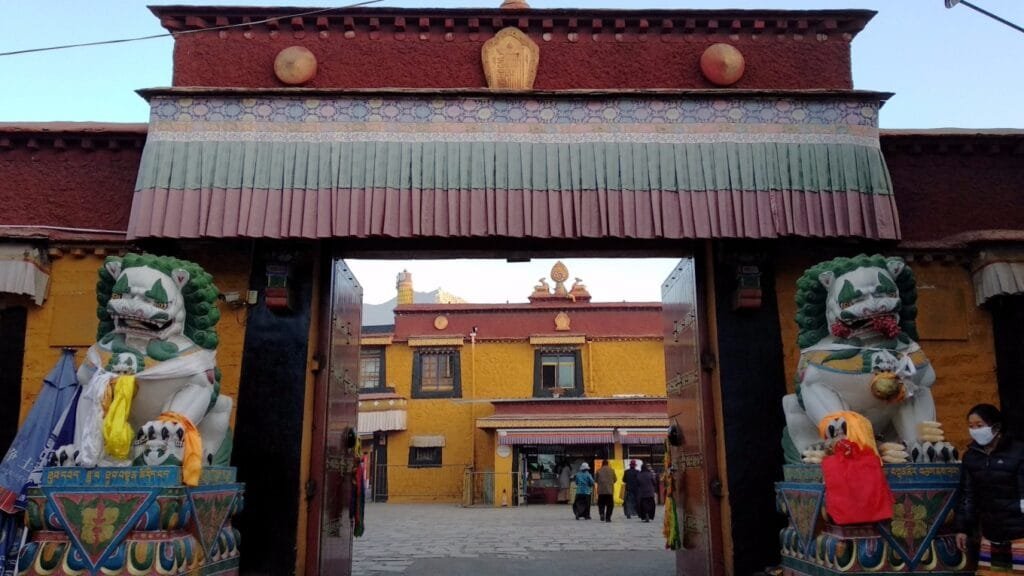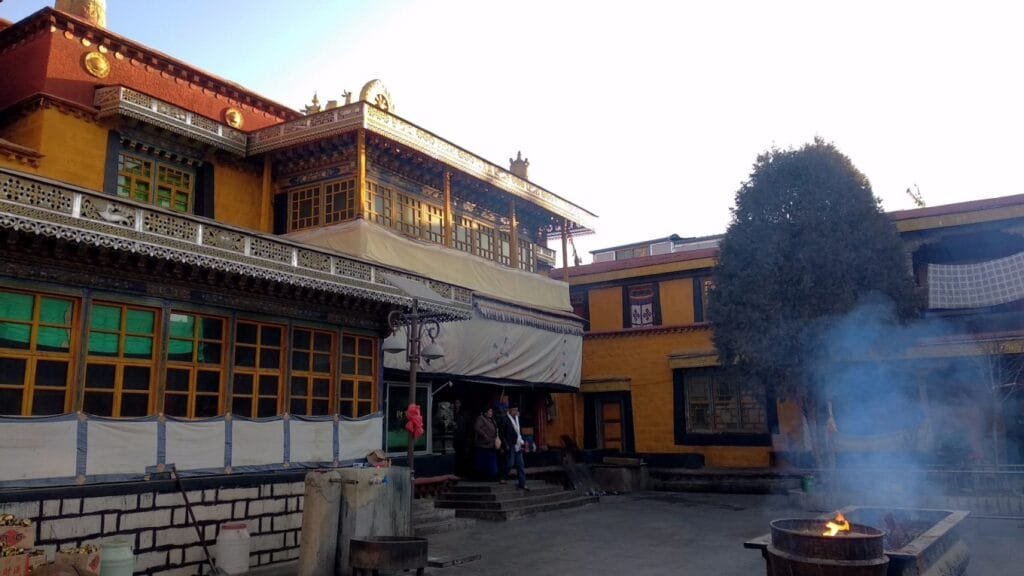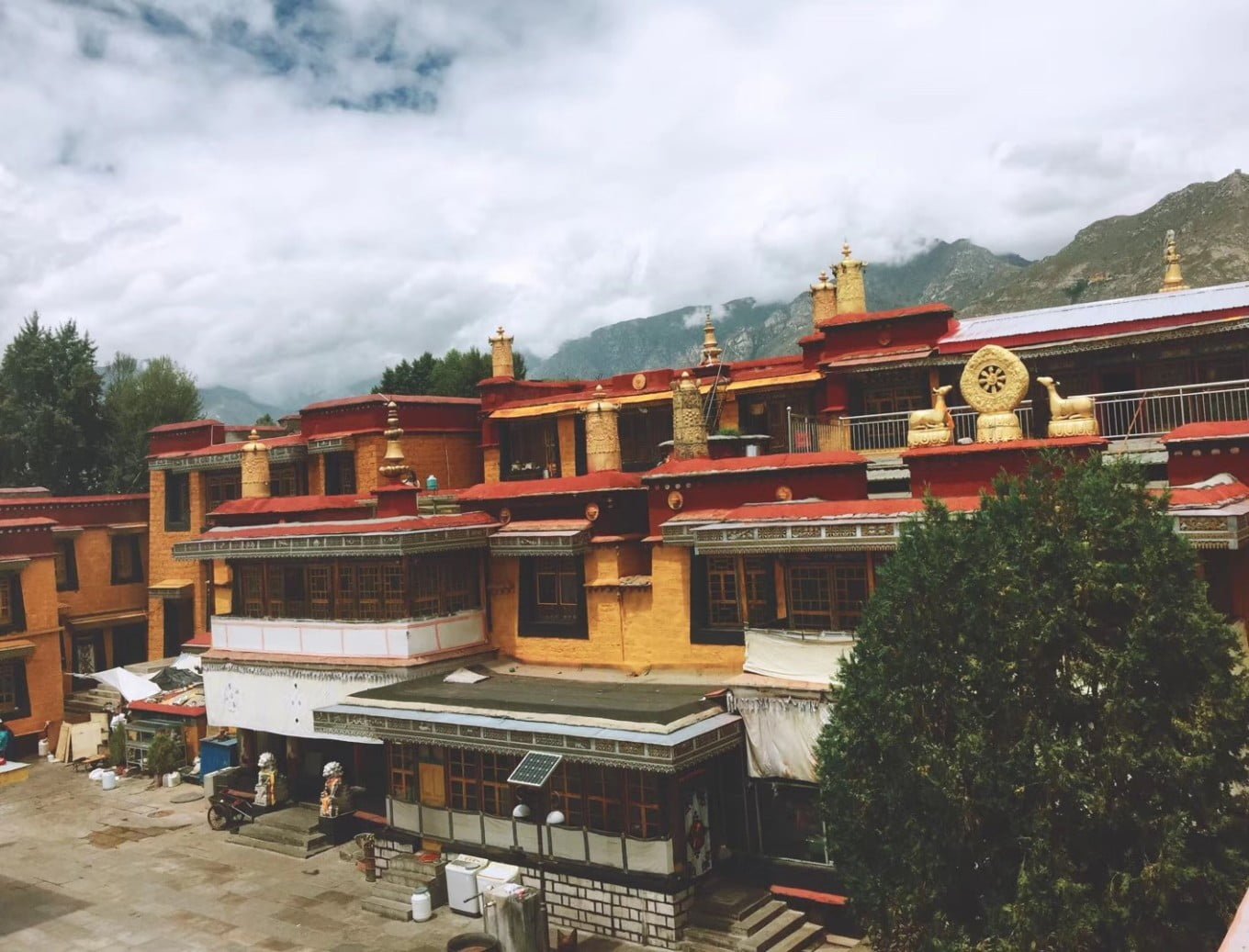Welcome to a captivating journey into Drapchi Monastery, a quaint yet profound spiritual haven situated in the northern expanses of Lhasa, Tibet. Merely 3 kilometers away from the renowned Sera Monastery, Drapchi Monastery, originally known as “གྲྭ་བཞི་བརྟེན་བཞུགས་ཆོས་འཁོར་གླིང་” captures the essence of Tibetan spirituality and history. Name is given by great 5th Dalai Lama, turn into Geluk Monastery. Established by Kyewu Tsang Jamyang Monlam (ཀེའུ་ཚང་འཇམ་དབྱངས་སྨོན་ལམ་དུས་རྒྱ་སྐྱེད་གནང་), the monastery began its journey with a mere four monks, thus initially known as Drapchi Gompa.
Despite its modest footprint, Drapchi Monastery is a bastion of spiritual depth, with its three-story main hall housing an eclectic mix of divine figures and deities revered in Tibetan Buddhism. Let’s delve into the unique spiritual landscape that Drapchi Monastery offers to both pilgrims and curious explorers alike.

A Sanctuary of Divine Figures
Upon entering the first floor, visitors encounter an impressive ensemble of sacred figures including the dense Vajradhara, thirteen Great Power Vajradhara, Sukhavati Vajradhara, Kalachakra, Amitayus, Vaishravana, Six-Armed Mahakala, and the local deity, Drapchi. These figures are central to the worship practices here and reflect the diverse facets of Tibetan Buddhism.
Ascending to the third floor unveils a sanctuary adorned with statues of pivotal Buddhist icons such as Sakyamuni Buddha, Dipankara Buddha, Amitayus, Avalokiteshvara, Green Tara, White Tara, Padmasambhava, alongside founders and masters of various Buddhist schools. The goddess of Drapchi, depicted with unique chicken feet and a protruding tongue, stands as a symbol of mystic power, her striking appearance inviting reflection on the myriad forms of divine presence in Tibetan Buddhism.

Drapchi Lhamo Goddess
The Drapchi goddess, with her distinct attributes, casts an aura of mystery and spiritual might. Surrounded by over sixty precious Buddha statues in the newly renovated main hall, she provides a focal point for devotion, drawing visitors into a deep spiritual dialogue. This enigmatic figure makes Drapchi Monastery a compelling site for those fascinated by the rich tapestry of deities within Tibetan spiritual tradition.
A Hub of Blessings and Prosperity
Drapchi Monastery distinguishes itself as the sole temple in Tibet dedicated to the God of Wealth. Despite its compact size, the monastery buzzes with life, particularly on auspicious days dedicated to wealth, safety, and health blessings. The air fills with the fragrance of sang (incense) and the offerings of alcohol during these gatherings, highlighting the monastery’s vibrant community life.
The wealth deity’s preference for strong liquor has led to the unique tradition of offering high-quality spirits, underscoring the cultural interplay between Tibetan traditions and broader influences. The Drapchi goddess, renowned for her efficacy in answering prayers, attracts a diverse following, including Han Chinese merchants and drivers seeking her protection and blessings.

Insights Through Divination
Drapchi Monastery is also celebrated for its divinatory practices. In the upper sanctuary, beneath the auspicious thangka, lies a divination tube, a focal point for those seeking guidance. After a silent prayer, a pilgrim may draw a divination stick, which is then interpreted by a senior monk through ancient Tibetan scriptures. This revered practice offers profound insights and guidance, enriching the spiritual experience for visitors.
The Legend of the Drapchi Goddess: Guardian and Protector
In the heart of Tibet, the Drapchi Goddess, known as “Drapchi Lhamo,” carries a tale of resilience, power, and protection. Her journey from the mainland to Tibet is a story marked by beauty, envy, and transcendence. Drapchi Lhamo was celebrated for her unparalleled beauty, which unfortunately sparked jealousy among the local female spirits of Lhasa. These spirits attempted to harm her by poisoning, but Drapchi Lhamo’s profound spiritual strength allowed her to force the poison to her tongue. Though she survived this ordeal, her tongue remained permanently extended, a distinctive feature of her formidable appearance.
The spirits, undeterred by their failure, resorted to a more drastic measure by severing her feet. In an extraordinary display of her divine powers, Drapchi Lhamo’s legs were replaced by chicken feet, transforming her into a revered mother deity with human form but chicken claws, known as the “Chicken Claw Goddess.” Her visage is fierce: skin dark as night, eyes wide and angry, mouth agape, and tongue stretched long—an image invoking both awe and terror.
Legend has it that Drapchi Lhamo ascended from the realm of demons to the divine, yet her mortal desires remained, making her a unique figure among deities. She is said to have 100 titles and 1,000 forms, patrolling the world daily, flying three times around it to devour demons and fulfill her mission as a protector of peace.
Visiting Tips for the Drapchi Monastery
- Monday is the Prime Day for wealth blessings, with many devotees bringing offerings of butter, high-quality alcohol, and Khada (traditional ceremonial scarves) in hopes of prosperity. Be prepared to wait in line due to the popularity of these blessings.
- Inside the monastery, visitors can find a variety of blessed amulets for sale, believed to offer protection to those who carry them.
- Just outside, there’s a tourist shop where visitors can purchase souvenirs to remember their spiritual journey.
The story of the Drapchi Goddess is a testament to the rich tapestry of Tibetan mythology, blending elements of strength, transformation, and vigilance against evil. A visit to Drapchi Monastery is not just a pilgrimage for spiritual seekers but also an opportunity to immerse in the stories that shape the identity of Tibet.

